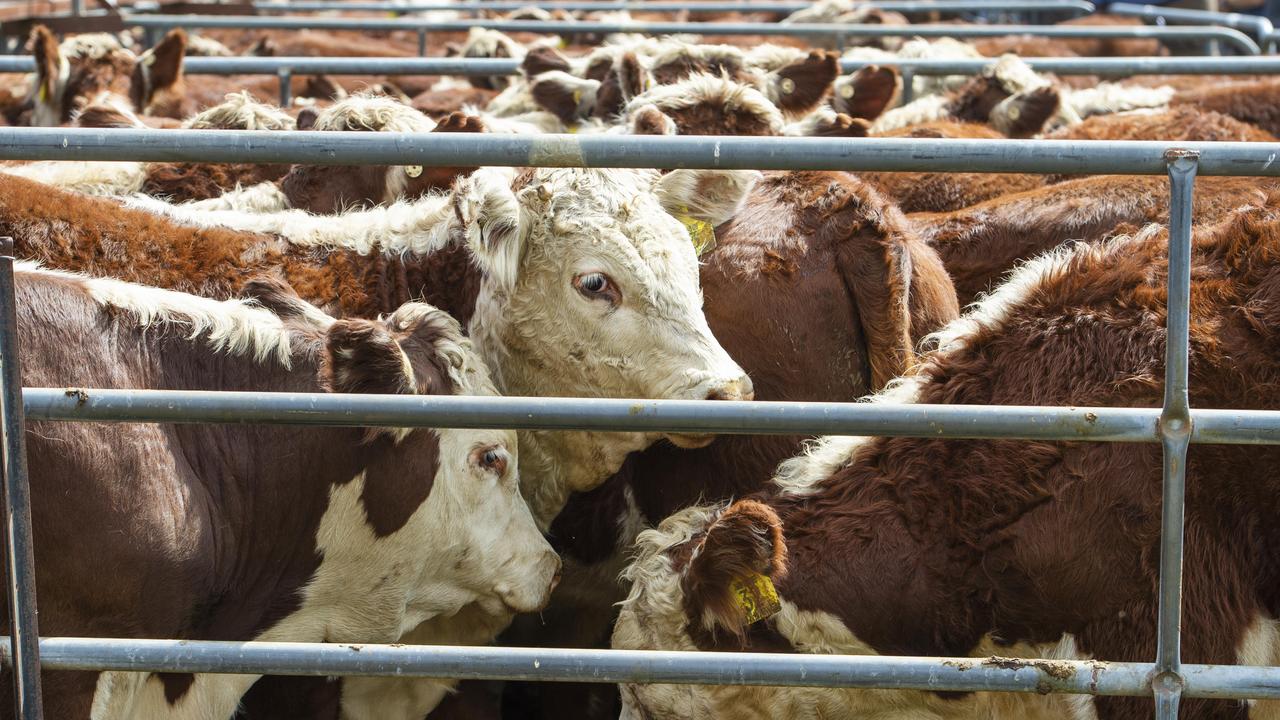Cattle market holds as lamb prices start to improve
Restockers and feedlots dominate beef markets, while lamb starts to show some winter form. See the top prices this week.

After some strong price gains in the past week, the cattle market has struggled to hold this high form in early trading this week.
Reports from major saleyards on Monday showed slightly easier price trends over young cattle to restockers and feedlots, while the bidding pace on cows and bullocks was also slower.
Price changes were generally just a few cents easier, and the best trade cattle to domestic processors remained in the range of recent sales due to limited supplies.
It is reflected in the latest price indicators issued by Meat and Livestock Australia, which on Monday were:
FEEDER steers at an average of 437c/kg liveweight, calculated on 5508 head sold on Monday to be firm on a week ago;
MEDIUM cows at 293c/kg from 664 head sold on Monday to be firm;
HEAVY steers 392c/kg from 392 head sold, easing 6c; and
YEARLING steers at 462c/kg, dipping 1c but on limited numbers sold, at just 81 head on Monday.
A breakdown of data in the Eastern Young Cattle Indicator shows feedlots and restockers continue to dominate the market. The latest figures had feedlots buying 46 per cent of all eligible young cattle in the EYCI, which are the better bred vealers and yearlings assessed as C-muscle. Restockers are tracking closely at 43 per cent, while processors currently are only absorbing 10 per cent of the stock.
Price is a factor in who is buying, with processors unwilling to match the higher price rates being paid by feeders and farmers. The average price in the EYCI paid by processors was 817c/kg carcass weight, compared to 841c/kg by feedlots while restockers are still way in front at 951c/kg.
Much of the high restocker price is being driven out of northern NSW and Queensland, and is based on young cattle less than 300kg.
On Monday 15 standout vealer steers at Pakenham sold from 490c/kg to a top of 530c/kg liveweight to average $2077, the NLRS said.
In the heavier cattle, the best heavy bullocks (C-muscle and in fat score 4 condition) sold from 413c/kg to a top of 423c/kg to average $2888.
Feeders were keen on grown steers lacking finish at Pakenham, paying from 403c/kg to 430c/kg for steers weighing 500-580kg, with the 106 head sold in this category averaging $2414.
Cows remain a big component of markets, accounting for a reasonable percentage of cattle at saleyards. At Wagga Wagga the main run of 236 heavy beef cows (D-muscle and fat score 4) sold from 302c/kg to 348c/kg to average 324c/kg or $2195.
BENDIGO SPIKES FOR PREMIUM POOL
Lamb is starting to show signs of some winter price movement, with segments of dearer sales recorded in early sales this week.
Nicely weighted domestic slaughter lambs sold to much dearer rates at Bendigo on Monday, some sales listed above 900c/kg carcass weight for pens that ticked all the boxes for shape, fat cover and skin length.
The trend is linked to supply, with fewer lambs available in the sought after size range of 20-24kg carcass weight that many top-end domestic orders prefer.
Highlighting this is overall data collected from saleyards by the National Livestock Reporting Service on Monday.
From the auctions held in Victoria, NSW and South Australia there were 18,264 crossbred lambs assessed by the NLRS, which calculated an average weight of 26.7kg for an average price result of $210. Break down this data further, and it shows a supply rate of about 4 heavy lambs (over 24kg) for every lamb in the 20-24kg range.
An example of this was at Bendigo on Monday, where the NLRS data showed nearly 2000 crossbred lambs in the main fat score four categories that weighed over 26kg, versus just a few hundred with this good finish in the ideal tradeweights. Highlighted at the Bendigo sale were neat lambs in the 20-22kg bracket, which sold to $216 and averaged close to 900c/kg. This was at a premium to the general run of mixed quality medium and heavy trade lambs which varied from 780c/kg to 870c/kg. The other strong segment of the Bendigo sale were heavy export lambs over 30kg, which had been struggling in the past fortnight. More export activity meant they sold to a top of $295 for a ballpark cost of 760c/kg.

However, while there were price spikes of $10 to $20 for lambs at Bendigo the dearer trend wasn’t evident at every saleyard.
The NSW centres of Corowa and Dubbo remained similar to a week ago, and overall there has only been modest change to the eastern states indicators. At the close of selling on Monday the heavy lamb indicator had moved up to 793c/kg carcass weight, and trade lambs were on 820c/kg — both categories showing improvements of around 10c/kg on a week ago. Merino lambs were listed at 761c/kg.
Looking at the broader picture of supply, there were still 377,166 lambs processed during the second week of May, with production still at much higher levels than 12 months ago when abattoirs could only find 318,000 head to slaughter.
Sheep numbers remain tight and signs of the mutton market ramping up have started to appear, with heavy sheep consistently making above $200 on Monday. There were reports of mutton costing over 700c/kg, with the official indicator up to 659c/kg.
MORE
EXPORTS DECLINE: WHAT COULD AFFECT RED MEAT THIS YEAR
SURGING US PRICES DRIVING THE BEEF MARKET
LAMB PRICES STAGGER INTO WINTER AS PROCESSORS JUGGLE CONTRACTS


